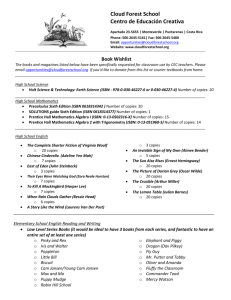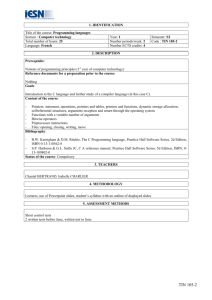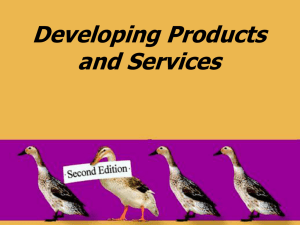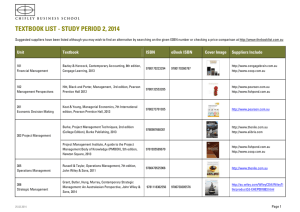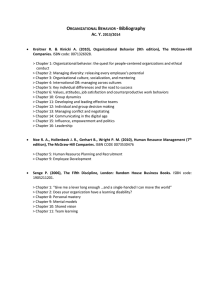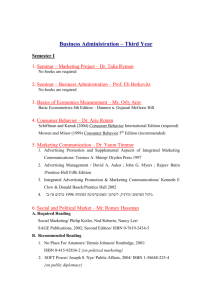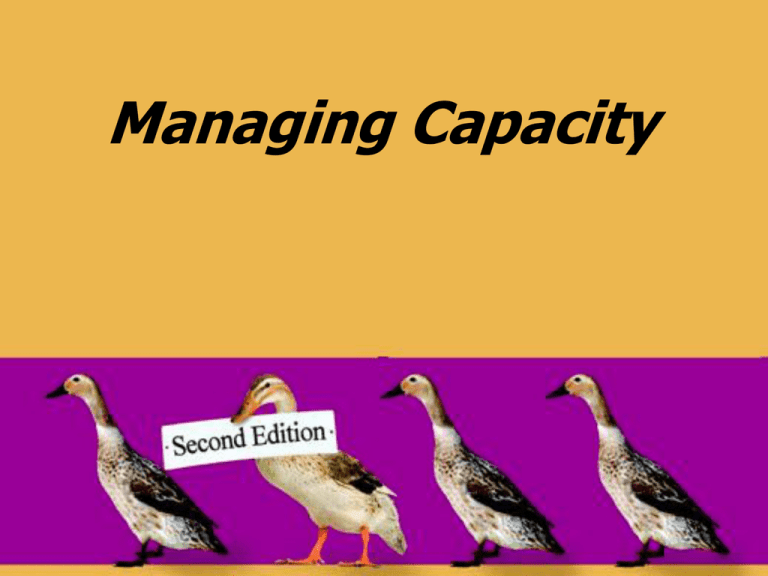
Managing Capacity
Chapter Objectives
Be able to:
Explain what capacity is, how firms measure
capacity, and the difference between theoretical
and rated capacity,
Describe the pros and cons associated with
three different capacity strategies: lead, lag, and
match.
Apply a wide variety of analytical tools to
capacity decisions, including expected value and
break-even analysis, decision trees, waiting line
theory, and learning curves.
© 2008 Pearson Prentice Hall --- Introduction to Operations and Supply
Chain Management, 2/e --- Bozarth and Handfield, ISBN: 0131791036
Chapter 8, Slide 2
Capacity Decisions
• Defining and measuring capacity
• Strategic versus tactical capacity
• Evaluating capacity alternatives
• Advanced perspectives
– Theory of Constraints
– Waiting lines
– Learning curves
© 2008 Pearson Prentice Hall --- Introduction to Operations and Supply
Chain Management, 2/e --- Bozarth and Handfield, ISBN: 0131791036
Chapter 8, Slide 3
Defining and Measuring Capacity
Measure of an organization’s ability to provide
goods or services
Jiffy Lube Oil changes per hour
Law firm Billable hours
College Student hours per semester
© 2008 Pearson Prentice Hall --- Introduction to Operations and Supply
Chain Management, 2/e --- Bozarth and Handfield, ISBN: 0131791036
Chapter 8, Slide 4
Consider:
Capacity for a PC Assembly Plant:
(800 units/shift/line)×(% Good)×(# of lines)×(# of Shifts)
Controllable Factors
1 or 2 shifts? 2 or 3 lines? Employee training?
Uncontrollable Factors
Supplier problems? 98% or 100% good? Late or on time?
© 2008 Pearson Prentice Hall --- Introduction to Operations and Supply
Chain Management, 2/e --- Bozarth and Handfield, ISBN: 0131791036
Chapter 8, Slide 5
Strategic versus Tactical
Capacity
• Strategic:
– One or more years out
– “Bricks & Mortar”
– Future technologies
• Tactical:
– One year or sooner
– Workforce level, schedules, inventory, etc.
© 2008 Pearson Prentice Hall --- Introduction to Operations and Supply
Chain Management, 2/e --- Bozarth and Handfield, ISBN: 0131791036
Chapter 8, Slide 6
Capacity
Capacity versus Time
Planning & Control
Tactical Planning
Strategic Capacity Planning
•Limited ability
to adjust
capacity
•Detailed planning
•Lowest risk
• Workforce, inventory,
subcontracting decisions
• Intermediate-level
planning
•Moderate risk
• “Bricks &
mortar” decisions
• High-level planning
• High risk
Days or weeks out
Months out
© 2008 Pearson Prentice Hall --- Introduction to Operations and Supply
Chain Management, 2/e --- Bozarth and Handfield, ISBN: 0131791036
Years out
Time
Chapter 8, Slide 7
Capacity Strategies: When,
How Much, and How?
Demand
Leader
Excess
Capacity
Lost Business
Laggard
© 2008 Pearson Prentice Hall --- Introduction to Operations and Supply
Chain Management, 2/e --- Bozarth and Handfield, ISBN: 0131791036
Chapter 8, Slide 8
How?
• Make or Buy (e.g., subcontracting)
• One extreme: “Virtual” Business
Walden Paddlers
(Marketing)
Hardigg Industries
(Manufacturing)
Independent Dealers
(Direct Sales)
General Composites
(Design)
© 2008 Pearson Prentice Hall --- Introduction to Operations and Supply
Chain Management, 2/e --- Bozarth and Handfield, ISBN: 0131791036
Chapter 8, Slide 9
Evaluating Capacity
Alternatives
•
•
•
•
Economies of scale (EOS)
Expected value analysis (EVA)
Decision Trees
Break-even points (BEP)
© 2008 Pearson Prentice Hall --- Introduction to Operations and Supply
Chain Management, 2/e --- Bozarth and Handfield, ISBN: 0131791036
Chapter 8, Slide 10
Economies of Scale
Total Cost for Fictional Line:
Fixed cost + (Variable unit cost)×(X)
= $200,000 + $4X
Cost per unit for X=1? X=10,000?
© 2008 Pearson Prentice Hall --- Introduction to Operations and Supply
Chain Management, 2/e --- Bozarth and Handfield, ISBN: 0131791036
Chapter 8, Slide 11
Shipping costs
Fixed & Unit Cost Scenarios
$40,000
$35,000
$30,000
$25,000
$20,000
$15,000
$10,000
$5,000
$0
5
15
25
35
45
55
65
75
Number of shipments
Common
Contract
© 2008 Pearson Prentice Hall --- Introduction to Operations and Supply
Chain Management, 2/e --- Bozarth and Handfield, ISBN: 0131791036
Private
Chapter 8, Slide 12
Indifference Point
Compares capacity alternatives — at what
volume level do they cost the same?
• Suppose one option has zero fixed cost and
$750 per unit cost; the other option has $5,000
fixed cost, but only $300 per unit cost.
$0 + $750X = $5,000 + $300X
What is the volume, X, at the indifference point?
© 2008 Pearson Prentice Hall --- Introduction to Operations and Supply
Chain Management, 2/e --- Bozarth and Handfield, ISBN: 0131791036
Chapter 8, Slide 13
Expected Value Analysis
Forecasted demand or volume is
uncertain, allows consideration of
the variability in the data
Data Requirements
Capacity cost structure
(alternatives?)
Expected demand
(multiple scenarios?)
EVA
Product and service
requirements
(e.g. time standards)
© 2008 Pearson Prentice Hall --- Introduction to Operations and Supply
Chain Management, 2/e --- Bozarth and Handfield, ISBN: 0131791036
Chapter 8, Slide 15
Expected Value Analysis
Pennington Cabinet Company
2000 jobs per year (20% likelihood)
5000 jobs per year (50%)
7000 jobs per year (30%)
Each job = $1,200 revenue
© 2008 Pearson Prentice Hall --- Introduction to Operations and Supply
Chain Management, 2/e --- Bozarth and Handfield, ISBN: 0131791036
Chapter 8, Slide 16
We Know:
• Average job requires:
2 hours of machine time
3-1/3 hours of assembly team time
• Machines and teams work 2000 hours per year
• Each machine and team has yearly fixed cost
= $200K
• 3 different capacity scenarios (see next slide!)
© 2008 Pearson Prentice Hall --- Introduction to Operations and Supply
Chain Management, 2/e --- Bozarth and Handfield, ISBN: 0131791036
Chapter 8, Slide 17
Effective Capacity
Number of Machines
and Teams
Number of Hours
Available Each Year
Maximum Jobs per
Year
Machines
Teams
Machines
Machines
Current
3
5
6,000
10,000
3,000
3,000
Expanded
5
9
10,000
18,000
5,000
5,400
New Site
7
12
14,000
24,000
7,000
7,200
Teams
Teams
What is the effective capacity
of each capacity alternative?
© 2008 Pearson Prentice Hall --- Introduction to Operations and Supply
Chain Management, 2/e --- Bozarth and Handfield, ISBN: 0131791036
Chapter 8, Slide 18
Alternate Demand Scenarios
Current Level
Expanded
New Site
Demand
Revenue
Fixed
Expenses
Revenue
Fixed
Expenses
Revenue
Fixed
Expenses
2,000
$2,400,000
$1,600,000
$2,400,000
$2,800,000
$2,400,000
$3,800,000
5,000
$3,600,000
$1,600,000
$6,000,000
$2,800,000
$6,000,000
$3,800,000
7,000
$3,600,000
$1,600,000
$6,000,000
$2,800,000
$8,400,000
$3,800,000
What is the expected contribution if demand = 5000
AND we decide to move to a new site?
Why does revenue for current capacity max out at
$3.6 million?
© 2008 Pearson Prentice Hall --- Introduction to Operations and Supply
Chain Management, 2/e --- Bozarth and Handfield, ISBN: 0131791036
Chapter 8, Slide 19
Net Revenue Table
Demand
Current
Expanded
New Site
3,000
$800,000
($400,000)
($1,400,000)
5,000
$2,000,000
$3,200,000
$2,200,000
7,000
$2,000,000
$3,200,000
$4,600,000
© 2008 Pearson Prentice Hall --- Introduction to Operations and Supply
Chain Management, 2/e --- Bozarth and Handfield, ISBN: 0131791036
Chapter 8, Slide 20
Expected Value of Each
Capacity Alternative:
Current capacity level
(20%) × $800K
+(50%) × $2000K
+(30%) × $2000K
=
$1,760,000
© 2008 Pearson Prentice Hall --- Introduction to Operations and Supply
Chain Management, 2/e --- Bozarth and Handfield, ISBN: 0131791036
Chapter 8, Slide 21
Expected Value of Each
Capacity Alternative:
Expanded capacity level
(20%) × – $400K
+ (50%) × $3200K
+ (30%) × $3200K
=
$2,480,000
© 2008 Pearson Prentice Hall --- Introduction to Operations and Supply
Chain Management, 2/e --- Bozarth and Handfield, ISBN: 0131791036
Chapter 8, Slide 22
Expected Value of Each
Capacity Alternative:
New Site capacity level
+
+
(20%) × – $1400K
(50%) × $2200K
(30%) × $4600K
=
$2,200,000
© 2008 Pearson Prentice Hall --- Introduction to Operations and Supply
Chain Management, 2/e --- Bozarth and Handfield, ISBN: 0131791036
Chapter 8, Slide 23
Conclusions for Pennington
• Which alternative would you choose if you
wanted to minimize the worst possible
outcome (Maximin)? Maximize the best
possible outcome (Maximax)?
• Why is it important to know effective
capacity? How could this help future
capacity decisions?
© 2008 Pearson Prentice Hall --- Introduction to Operations and Supply
Chain Management, 2/e --- Bozarth and Handfield, ISBN: 0131791036
Chapter 8, Slide 24
Decision Trees
• Visual tool for evaluating choices
using expected value analysis
• Allows use of different outcomes
and different probabilities of
success for each
Decision Tree Requirements
• Decision points represented by
– Choose the best input — the highest EVA, lowest
cost, least risk, etc.
• Outcome points represented by
– Summation of all inputs (outcomes) weighted by their
respective probabilities. No choice can be made at
these points
• Trees drawn from final decision to the outcomes
affecting that decision, then on to lower level
decisions that might affect the those outcomes,
then the lower level outcomes affecting those
lower level decisions, and so on
© 2008 Pearson Prentice Hall --- Introduction to Operations and Supply
Chain Management, 2/e --- Bozarth and Handfield, ISBN: 0131791036
Chapter 8, Slide 26
Ellison Seafood Example
Here the probabilities
affecting the demand
level are the same for
the three options
considered.
But the decision tree
does allow them to be
different, can you
think of situations
where this might be
true?
© 2008 Pearson Prentice Hall --- Introduction to Operations and Supply
Chain Management, 2/e --- Bozarth and Handfield, ISBN: 0131791036
Chapter 8, Slide 27
Decision Tree Criteria
• Book example illustrates selecting highest
revenue option.
• Other option choices can be on basis of:
– Using total cost for outcomes (useful when selling
price is not known)
– Using estimated risk for outcomes
– Outcomes reflecting a desired result (choose highest
EVA) Can you think of an example?
– Outcomes reflecting undesirable results (choose
lowest EVA) Can you think of an example?
© 2008 Pearson Prentice Hall --- Introduction to Operations and Supply
Chain Management, 2/e --- Bozarth and Handfield, ISBN: 0131791036
Chapter 8, Slide 28
Break-Even Point (BEP)
Considers revenue and costs, at what
volume level are they equal?
• Suppose each unit sells for $100, the fixed cost
is $200,000 and the variable cost is $4
BEP $100X = $200,000 + $4X
What is the breakeven volume, X?
© 2008 Pearson Prentice Hall --- Introduction to Operations and Supply
Chain Management, 2/e --- Bozarth and Handfield, ISBN: 0131791036
Chapter 8, Slide 29
Self Test
• EBB Industries must decide whether to invest in
a new machine which has a yearly fixed cost of
$40,000 and a variable cost of $50 per unit.
• What is the break even point (BEP) if each unit
sells for $200?
• What is the expected value, given the following
demand probabilities:
250 units (25%), 300 units (50%), 350 units (25%)
© 2008 Pearson Prentice Hall --- Introduction to Operations and Supply
Chain Management, 2/e --- Bozarth and Handfield, ISBN: 0131791036
Chapter 8, Slide 30
Advanced Perspectives
• Theory of Constraints
• Waiting lines
•Learning curves
Theory of Constraints
Concept that the throughput of a supply chain is
limited (constrained) by the process step with the
lowest capacity.
Sounds logical, but what does this mean for managing the
other process steps?
Theory of Constraints
• Pipeline analogy
• Which piece of the pipe is restricting the
flow?
• Would making parts A or D bigger help?
© 2008 Pearson Prentice Hall --- Introduction to Operations and Supply
Chain Management, 2/e --- Bozarth and Handfield, ISBN: 0131791036
Chapter 8, Slide 33
Dealing with a Constraint
Identify the constraint
Exploit the constraint
Keep it busy!
Subordinate everything to the constraint
Make supporting it the overall priority
Elevate the constraint
Try to increase its capacity — more hours, screen out defective
parts from previous step, …
Find the new constraint and repeat
As one step is removed as a constraint, a new one will emerge.
Which piece of the pipe on the previous slide would be the new
constraint if Part C was increased in diameter?
© 2008 Pearson Prentice Hall --- Introduction to Operations and Supply
Chain Management, 2/e --- Bozarth and Handfield, ISBN: 0131791036
Chapter 8, Slide 34
Waiting Lines
• Waiting lines and services
– Waiting and customer satisfaction
– Factors affecting satisfaction
• Waiting Line Theory
– Terminology and assumptions
– Illustrative example
© 2008 Pearson Prentice Hall --- Introduction to Operations and Supply
Chain Management, 2/e --- Bozarth and Handfield, ISBN: 0131791036
Chapter 8, Slide 35
Waiting at Outback
Steakhouse...
Waiting
outside
or in bar
Waiting to get food...
Leaving
restaurant
Waiting to pay bill ...
© 2008 Pearson Prentice Hall --- Introduction to Operations and Supply
Chain Management, 2/e --- Bozarth and Handfield, ISBN: 0131791036
Chapter 8, Slide 36
Key Points
• Waiting time DECREASES value-added
experience
• On the other hand, adding serving
capacity INCREASES costs
• Businesses must have a way to analyze
the impact of capacity decisions in
environments where waiting occurs
© 2008 Pearson Prentice Hall --- Introduction to Operations and Supply
Chain Management, 2/e --- Bozarth and Handfield, ISBN: 0131791036
Chapter 8, Slide 37
COST
Waiting and Customer
Satisfaction
Cost of
service
Cost of
waiting
Lost
customers
Waiting time
© 2008 Pearson Prentice Hall --- Introduction to Operations and Supply
Chain Management, 2/e --- Bozarth and Handfield, ISBN: 0131791036
Chapter 8, Slide 38
Cost of Waiting = f(Satisfaction)
Factors Affecting Satisfaction
1. Firm-related factors
2. Customer-related factors
© 2008 Pearson Prentice Hall --- Introduction to Operations and Supply
Chain Management, 2/e --- Bozarth and Handfield, ISBN: 0131791036
Chapter 8, Slide 39
Firm-Related Factors
• “Unfair” versus “fair” waits
• Uncomfortable versus comfortable
waits
• Initial versus subsequent waits
• Capacity decisions
© 2008 Pearson Prentice Hall --- Introduction to Operations and Supply
Chain Management, 2/e --- Bozarth and Handfield, ISBN: 0131791036
Chapter 8, Slide 40
Waiting Line (Queuing) Theory
• Application of statistics to allow us to
perform a detailed analysis of system
– Utilization levels, line lengths, etc.
• Terminology and assumptions
© 2008 Pearson Prentice Hall --- Introduction to Operations and Supply
Chain Management, 2/e --- Bozarth and Handfield, ISBN: 0131791036
Chapter 8, Slide 41
Terminology and Assumptions I
Line
Phase
?
Service
System
© 2008 Pearson Prentice Hall --- Introduction to Operations and Supply
Chain Management, 2/e --- Bozarth and Handfield, ISBN: 0131791036
Chapter 8, Slide 42
Terminology and Assumptions
II
Single-Channel
Single-Phase
?
Service
?
Service
Multiple-Channel
Single-Phase
?
Service
© 2008 Pearson Prentice Hall --- Introduction to Operations and Supply
Chain Management, 2/e --- Bozarth and Handfield, ISBN: 0131791036
Chapter 8, Slide 43
Terminology and Assumptions
III
Complex service environment ...
?
Service
?
Service
?
Service
?
Service
?
Service
© 2008 Pearson Prentice Hall --- Introduction to Operations and Supply
Chain Management, 2/e --- Bozarth and Handfield, ISBN: 0131791036
How
would
you
describe
this?
Chapter 8, Slide 44
Terminology and Assumptions
IV
• Population: Infinite or Finite
• Arrival rates:
Random or constant rate
– Random rates typically defined by Poisson
distribution for infinite population
• Service Rates: Random or constant
– Random service rates typically described by
exponential distribution
• Priority rules (aka “Queue Discipline”)
• Permissible queue length
© 2008 Pearson Prentice Hall --- Introduction to Operations and Supply
Chain Management, 2/e --- Bozarth and Handfield, ISBN: 0131791036
Chapter 8, Slide 45
Example
• A single drive-in window for Bank
• Arrival rate
– 15 per hour, on average
• Service rate
– 20 per hour, on average
• How many channels? Phases?
• What kinds of questions might we have?
© 2008 Pearson Prentice Hall --- Introduction to Operations and Supply
Chain Management, 2/e --- Bozarth and Handfield, ISBN: 0131791036
Chapter 8, Slide 46
Drive-In Bank
= arrival rate = 15 cars per hour
=
service rate = 20 cars per hour
Average utilization of the system:
= = 0.75
© 2008 Pearson Prentice Hall --- Introduction to Operations and Supply
Chain Management, 2/e --- Bozarth and Handfield, ISBN: 0131791036
Chapter 8, Slide 47
Drive-In Bank
Probability of n arrivals during period T is:
( T ) T
Pn
e
n!
n
e.g., probability of only 4 arrivals during a
45-minute period is:
(15 0.75) 150.75
P4
e
0.87%
4!
4
© 2008 Pearson Prentice Hall --- Introduction to Operations and Supply
Chain Management, 2/e --- Bozarth and Handfield, ISBN: 0131791036
Chapter 8, Slide 48
Drive-In Bank
Average number of cars in the system:
(waiting plus being served)
15
Cs
3.0 cars
( ) (20 15)
© 2008 Pearson Prentice Hall --- Introduction to Operations and Supply
Chain Management, 2/e --- Bozarth and Handfield, ISBN: 0131791036
Chapter 8, Slide 49
Drive-In Bank
Average number of cars waiting:
2
Cw
Cs
( )
( )
2
15
225
Cw
2.25 cars
20 (20 15) 100
© 2008 Pearson Prentice Hall --- Introduction to Operations and Supply
Chain Management, 2/e --- Bozarth and Handfield, ISBN: 0131791036
Chapter 8, Slide 50
Drive-In Bank
Average time spent in the system:
(waiting plus being served)
1
1
Ts
0.2 hours 12 minutes
( ) (20 15)
(How do we know the answer is in hours?)
© 2008 Pearson Prentice Hall --- Introduction to Operations and Supply
Chain Management, 2/e --- Bozarth and Handfield, ISBN: 0131791036
Chapter 8, Slide 51
Drive-In Bank
Average time spent in the line:
TW
Ts 0.75 0.2 hours 9 minutes
( )
(How do we know the answer is in hours?)
© 2008 Pearson Prentice Hall --- Introduction to Operations and Supply
Chain Management, 2/e --- Bozarth and Handfield, ISBN: 0131791036
Chapter 8, Slide 52
Question?
What happens as the arrival rate
approaches the service rate?
Suppose is now 19 cars per
hour
One Answer:
Average number of cars waiting:
19
Cw
18.05 cars
( ) 20 (20 19)
2
2
Implications? What are we assuming here?
© 2008 Pearson Prentice Hall --- Introduction to Operations and Supply
Chain Management, 2/e --- Bozarth and Handfield, ISBN: 0131791036
Chapter 8, Slide 54
Other Types of Systems
(Discussed in the supplement to Chapter 8)
• Single-channel, single-phase with
constant service time
– Example: Automatic car wash
• Multiple-channel, multiple-phase
(hospital)
– Usually best handled using
simulation analysis
© 2008 Pearson Prentice Hall --- Introduction to Operations and Supply
Chain Management, 2/e --- Bozarth and Handfield, ISBN: 0131791036
Chapter 8, Slide 55
Self Test I
• Look back at the drive-in window example.
How can we have an average line length > 1
while the average number of cars being served
is < 1?
• Similarly, what happens as the arrival rate
approaches the service rate?
• Suppose the teller at the drive-in window is
given training and can now handle 25 cars an
hour (a 25% increase in service rate). What
happens to the average length of the line?
© 2008 Pearson Prentice Hall --- Introduction to Operations and Supply
Chain Management, 2/e --- Bozarth and Handfield, ISBN: 0131791036
Chapter 8, Slide 56
Self Test II
• Look back at the Outback Steakhouse
example. What kind of queuing system
is it?
© 2008 Pearson Prentice Hall --- Introduction to Operations and Supply
Chain Management, 2/e --- Bozarth and Handfield, ISBN: 0131791036
Chapter 8, Slide 57
Question?
How can capacity change, even
when we do not hire new people
or put in new equipment?
Learning Curves
• Recognize that people (and often
equipment) become more productive
over time due to learning.
• First observed in aircraft production
during World War II
• Getting more emphasis as companies
outsource more activities
© 2008 Pearson Prentice Hall --- Introduction to Operations and Supply
Chain Management, 2/e --- Bozarth and Handfield, ISBN: 0131791036
Chapter 8, Slide 59
A Formal Definition
For every doubling of cumulative output, there will be
a set percentage improvement in time per unit or some
other measure of input
Time
per
unit
10 hrs.
8 hrs.
80% learning curve Where does the name come from?
6.4 hrs.
5.12 hrs.
1 2
4
8
© 2008 Pearson Prentice Hall --- Introduction to Operations and Supply
Chain Management, 2/e --- Bozarth and Handfield, ISBN: 0131791036
4.096 hrs.
16
Output
Chapter 8, Slide 60
A Formal Definition (cont’d)
Tn T1n
b
Where:
Tn = time for the nth unit
T1 = time for the first unit
b = ln(learning percent) / ln2
© 2008 Pearson Prentice Hall --- Introduction to Operations and Supply
Chain Management, 2/e --- Bozarth and Handfield, ISBN: 0131791036
Chapter 8, Slide 61
Example
•
•
•
•
•
Reservation clerk at Delta Airlines
First call (while training) takes 8 minutes
Second call takes 6 minutes
What is the learning rate?
How long would you expect the 4th call to
take? The 16th? The 32nd?
© 2008 Pearson Prentice Hall --- Introduction to Operations and Supply
Chain Management, 2/e --- Bozarth and Handfield, ISBN: 0131791036
Chapter 8, Slide 62
Key Points
• Quick improvements early on, followed by
more and more gradual improvements
• The lower the percentage, the steeper the
learning curve
• Practically speaking, there is a floor
• Estimates of effective capacity must consider
learning effects!
© 2008 Pearson Prentice Hall --- Introduction to Operations and Supply
Chain Management, 2/e --- Bozarth and Handfield, ISBN: 0131791036
Chapter 8, Slide 63
Another Question . . .
How could learning curves be
used in long-term purchasing
contracts?
Johnston Controls I
• Johnston Controls won a contract to produce 2
prototype units for a new type of computer.
• First unit took 5,000 hrs. to produce and $250K
of materials
• Second unit took 3,500 hrs. to produce and
$200K of materials
• Labor costs are $30/hour
© 2008 Pearson Prentice Hall --- Introduction to Operations and Supply
Chain Management, 2/e --- Bozarth and Handfield, ISBN: 0131791036
Chapter 8, Slide 65
Johnston Controls II
• The customer has asked Johnston
Controls to prepare a bid for an
additional 10 units.
• What are Johnston’s expected costs?
© 2008 Pearson Prentice Hall --- Introduction to Operations and Supply
Chain Management, 2/e --- Bozarth and Handfield, ISBN: 0131791036
Chapter 8, Slide 66
Johnston Controls III
• Labor learning rate:
3500 hours / 5000 hours = 70%
• Materials learning rate:
$200K / $250K = 80%
© 2008 Pearson Prentice Hall --- Introduction to Operations and Supply
Chain Management, 2/e --- Bozarth and Handfield, ISBN: 0131791036
Chapter 8, Slide 67
Johnston Controls IV
• “Additional 10 units” means the third through
twelfth units.
• Total labor for units 3 through 12:
= 5,000 hours × (5.501 – 1.7)
= 19,005 hrs
5.501 is sum of nb for 12 units
1.7 is the sum of nb for the first two units
© 2008 Pearson Prentice Hall --- Introduction to Operations and Supply
Chain Management, 2/e --- Bozarth and Handfield, ISBN: 0131791036
Chapter 8, Slide 68
Johnston Controls V
• Total material for units 3 through 12:
= $250,000 × (7.227 – 1.8)
= $1,356,750
© 2008 Pearson Prentice Hall --- Introduction to Operations and Supply
Chain Management, 2/e --- Bozarth and Handfield, ISBN: 0131791036
Chapter 8, Slide 69
Johnston Controls VI
• Total cost for “additional 10 units”:
= $30 × (19,005 hours) + $1,356,750
= $1,926,900
What if there is a significant delay before
the second contract?
© 2008 Pearson Prentice Hall --- Introduction to Operations and Supply
Chain Management, 2/e --- Bozarth and Handfield, ISBN: 0131791036
Chapter 8, Slide 70
Self-Test
• Assume that there WILL BE a
significant delay before Johnston
Controls makes the next 10 units.
Assuming that Johnston has to “start
over” with regard to learning, estimate
total cost for these additional 10 units.
© 2008 Pearson Prentice Hall --- Introduction to Operations and Supply
Chain Management, 2/e --- Bozarth and Handfield, ISBN: 0131791036
Chapter 8, Slide 71
Case Study in Managing
Capacity
Forster’s Market


